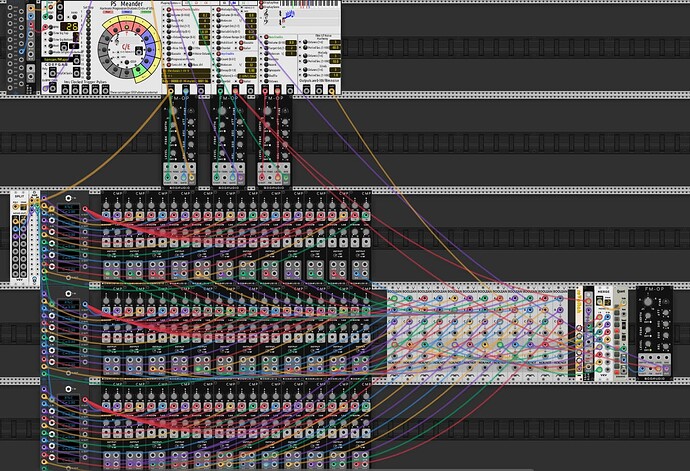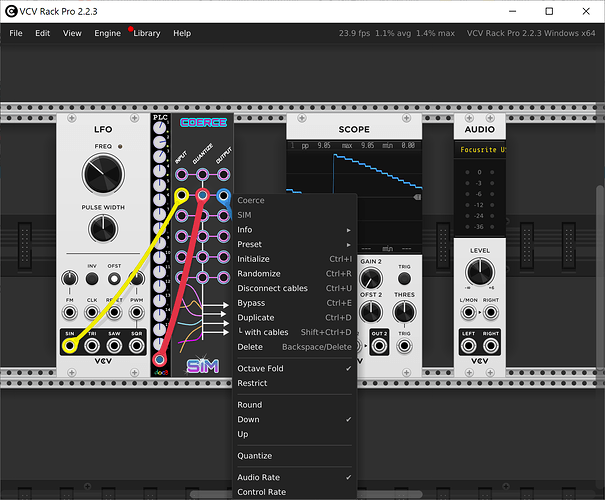Oops, I was wrong about Tint. It’s quantizing the voltages I put in the CHORD input to equal temperament tuning.
Is there any way to build a module like this that only outputs exactly the voltages I give it (and their octaves), and doesn’t change my Pythagorean fifth (0.585v) to an equal-temperament one (0.583v)?
2 Likes
Yes - the Tintinnabulator is currently locked to an equal temperament quantization. I’ll have a think on how to generalize to other tunings - for now I’ve added your request as a feature request at: Generalize the Tintinnabulator to non-equal temperament tuning · Issue #5 · chinenual/Chinenual-VCV · GitHub
1 Like
I’m always looking for a “quantize to chord” quantizer but end up creating my own, with mixed results.
Here is a successful attempt at building a quantize to triad chord quantizer, but it is horribly complex.
I don’t want to take over this thread - which is about a great collection of modules, and not some other thing that I want - but I’m about at the point of offering a bounty for this tool I want to use. @Chinenual would you prefer that I talk to you about this idea, or start another thread and open it up to the community?
You mean something like this?
1 Like
That’s very interesting, where’d you get it?
Like yourself, I felt an arbitrary array quantizer was missing, so I added it to the plugin suite I’m trying to make.
It probably has a few bugs, but if you’re interested, feel free to send me a direct message and you can try it out.
Since you ask on this thread, I assume something about my modules inspired the question, so ask ahead!
Well, what I very much wish I had is very close to what Tint does - a module that I can input (a) A polyphonic array of CVs, and (b) a voltage to quantize to the values of the polyphonic CVs, or their octaves. Tint does this, but defines pitch CV in terms of 12edo tuning. I intend to use this tool for non-12edo pitch ratios, as well as harmonic and inharmonic ratios of LFOs. So like this for instance:
CHORD input: [0, 0.322, 0.4, 0.585]
Melody input: (0-2v ramp up)
–
Tint output: 0, 0.322, 0.4, 0.585, 1, 1.322, 1.4, 1.585, 2
I recognize that this request is maybe beside the point of the use you have in mind for this module - it’s not my goal to harmonize like Arvo - but as it is it’s so close to something I would find super useful, and I’d be real grateful if it worked like that
Stand by. I have this working “in the lab”. Will roll it out (along with the fix for the Windows NoteMeter crash) as a new beta as soon as I finish testing.
That’s awesome. I’d award extra points for an “equidistant mode” like for instance the Grande QUANT has, but full marks for non-12edo quantization as described. Thanks!
So, this new module could quantize to a chord? I’m mocking it up with BASICally, but if you already have this planned, I will not spend too much time on it. Thanks.
The new Tintinnabulator quantizes to the chord exactly as input without snapping them to 12edo. So if you input C4+20c,E4+30c,G4-11c, the tintannabulated output is going to be some selection of C4+20c (or C5+20c if Octave+1 for example) or E4+30c or G4-11c. I believe this will preserve whatever weird tunings you throw at it.
2 Likes
Having thought about this, the Tininnabulator is a little more than a simple chord quantizer - since it’s specifically rejecting the case where the input melody note matches one of the chord values.
But all the logic is already there to support general quantization.
I’ll consider adding an extra mode to change that to do simple quantization instead of “tintinnabulation” which seeks a harmony note rather than just snapping to the reference chord.
2 Likes
That sounds good. Just to make sure, I want to input an arbitrary n-chord into the module and then input arbitrary single notes and have them quantized to the chord notes. I do something similar a lot with Meander where I “arp” the chord notes in all sorts of ways via sequential switches.
Well - the melody input of the Tintinnabulator is polyphonic. The module produces a new value for each entry in the channel. So if you enter 2 notes on the Melody, you get two notes out on the Tint output. It doesn’t randomly select them (it’s not an arpeggiator). But other than that, I think it does what you’re asking for. Kick the tires and let me know… I’ll report back when the beta is ready to test.
2 Likes
OK - time for a new beta. I found and fixed a buffer overflow that probably caused the NoteMeter Windows crash and added new features to the Tintinnabulator.
- Implements issue #5.
The Tintinabulator now supports non-equal temperament tunings.
- Implements issue #6.
The Tintinabulator has a new mode, Quantize, that simply snaps the
input melody to the nearest “Chord” frequency. This is technically
not “tintinnabulation” since if the melody note matches a chord
note, it will not create a “harmony” note. However, this allows the
Tintinnabulator to be used as a general purpose “chord quantizer”.
- Fixes issue #4
NoteMeter crash reported on Windows.
Get your copy here:
2 Likes
The new quantize to chord mode seems to be doing what I had in mind.
The NoteMeter no longer crashes when I add inputs.
Looks good. Thanks.
1 Like
Oops, I just crashed by sending a BOA LLFO to the melody input on Tint. No indication in the log file on what caused the crash or Rack exit.

